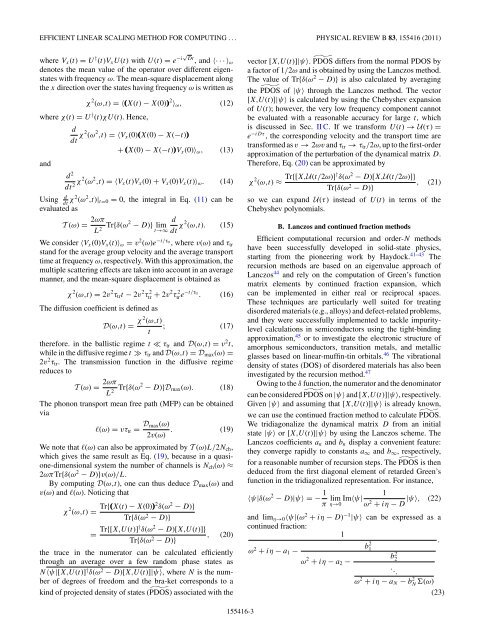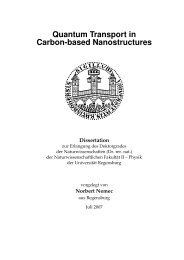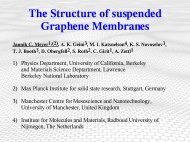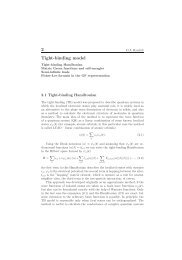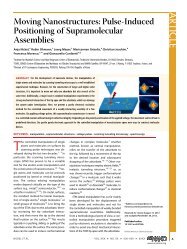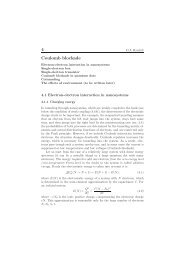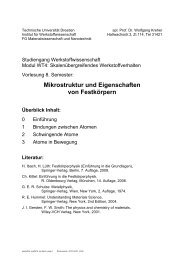Efficient linear scaling method for computing the thermal conductivity ...
Efficient linear scaling method for computing the thermal conductivity ...
Efficient linear scaling method for computing the thermal conductivity ...
Create successful ePaper yourself
Turn your PDF publications into a flip-book with our unique Google optimized e-Paper software.
EFFICIENT LINEAR SCALING METHOD FOR COMPUTING ... PHYSICAL REVIEW B 83, 155416 (2011)<br />
where Vx(t) = U † (t)VxU(t) with U(t) = e −i√ Dt , and 〈···〉ω<br />
denotes <strong>the</strong> mean value of <strong>the</strong> operator over different eigenstates<br />
with frequency ω. The mean-square displacement along<br />
<strong>the</strong> x direction over <strong>the</strong> states having frequency ω is written as<br />
χ 2 (ω,t) =〈(X(t) − X(0)) 2 〉ω, (12)<br />
where χ(t) = U † (t)χU(t). Hence,<br />
d<br />
dt χ 2 (ω 2 ,t) =〈Vx(0)(X(0) − X(−t))<br />
+ (X(0) − X(−t))Vx(0)〉ω, (13)<br />
and<br />
d2 dt2 χ 2 (ω 2 ,t) =〈Vx(t)Vx(0) + Vx(0)Vx(t)〉ω. (14)<br />
Using d<br />
dt χ 2 (ω2 ,t)|t=0 = 0, <strong>the</strong> integral in Eq. (11) can be<br />
evaluated as<br />
T (ω) = 2ωπ<br />
L2 Tr{δ(ω2 d<br />
− D)} lim<br />
t→∞ dt χ 2 (ω,t). (15)<br />
We consider 〈Vx(0)Vx(t)〉ω = v2 (ω)e−t/τtr , where v(ω) and τtr<br />
stand <strong>for</strong> <strong>the</strong> average group velocity and <strong>the</strong> average transport<br />
time at frequency ω, respectively. With this approximation, <strong>the</strong><br />
multiple scattering effects are taken into account in an average<br />
manner, and <strong>the</strong> mean-square displacement is obtained as<br />
χ 2 (ω,t) = 2v 2 τtrt − 2v 2 τ 2<br />
tr + 2v2τ 2<br />
tre−t/τtr . (16)<br />
The diffusion coefficient is defined as<br />
D(ω,t) = χ 2 (ω,t)<br />
; (17)<br />
t<br />
<strong>the</strong>re<strong>for</strong>e. in <strong>the</strong> ballistic regime t ≪ τtr and D(ω,t) = v2t, while in <strong>the</strong> diffusive regime t ≫ τtr and D(ω,t) = Dmax(ω) =<br />
2v2τtr. The transmission function in <strong>the</strong> diffusive regime<br />
reduces to<br />
T (ω) = 2ωπ<br />
L2 Tr{δ(ω2 − D)}Dmax(ω). (18)<br />
The phonon transport mean free path (MFP) can be obtained<br />
via<br />
ℓ(ω) = vτtr = Dmax(ω)<br />
. (19)<br />
2v(ω)<br />
We note that ℓ(ω) can also be approximated by T (ω)L/2Nch,<br />
which gives <strong>the</strong> same result as Eq. (19), because in a quasione-dimensional<br />
system <strong>the</strong> number of channels is Nch(ω) ≈<br />
2ωπTr{δ(ω2 − D)}v(ω)/L.<br />
By <strong>computing</strong> D(ω,t), one can thus deduce Dmax(ω) and<br />
v(ω) and ℓ(ω). Noticing that<br />
χ 2 (ω,t) = Tr{(X(t) − X(0))2δ(ω2 − D)}<br />
Tr{δ(ω2 − D)}<br />
= Tr{[X,U(t)]† δ(ω2 − D)[X,U(t)]}<br />
Tr{δ(ω2 , (20)<br />
− D)}<br />
<strong>the</strong> trace in <strong>the</strong> numerator can be calculated efficiently<br />
through an average over a few random phase states as<br />
N〈ψ|[X,U(t)] † δ(ω2 − D)[X,U(t)]|ψ〉, where N is <strong>the</strong> number<br />
of degrees of freedom and <strong>the</strong> bra-ket corresponds to a<br />
kind of projected density of states (PDOS) associated with <strong>the</strong><br />
155416-3<br />
vector [X,U(t)]|ψ〉. PDOS differs from <strong>the</strong> normal PDOS by<br />
a factor of 1/2ω and is obtained by using <strong>the</strong> Lanczos <strong>method</strong>.<br />
The value of Tr{δ(ω2 − D)} is also calculated by averaging<br />
<strong>the</strong> PDOS of |ψ〉 through <strong>the</strong> Lanczos <strong>method</strong>. The vector<br />
[X,U(t)]|ψ〉 is calculated by using <strong>the</strong> Chebyshev expansion<br />
of U(t); however, <strong>the</strong> very low frequency component cannot<br />
be evaluated with a reasonable accuracy <strong>for</strong> large t, which<br />
is discussed in Sec. II C. If we trans<strong>for</strong>m U(t) → U(τ) =<br />
e−iDτ , <strong>the</strong> corresponding velocity and <strong>the</strong> transport time are<br />
trans<strong>for</strong>med as v → 2ωv and τtr → τtr/2ω, up to <strong>the</strong> first-order<br />
approximation of <strong>the</strong> perturbation of <strong>the</strong> dynamical matrix D.<br />
There<strong>for</strong>e, Eq. (20) can be approximated by<br />
χ 2 (ω,t) ≈ Tr{[X,U(t/2ω)]† δ(ω2 − D)[X,U(t/2ω)]}<br />
Tr{δ(ω2 , (21)<br />
− D)}<br />
so we can expand U(τ) instead of U(t) in terms of <strong>the</strong><br />
Chebyshev polynomials.<br />
B. Lanczos and continued fraction <strong>method</strong>s<br />
<strong>Efficient</strong> computational recursion and order-N <strong>method</strong>s<br />
have been successfully developed in solid-state physics,<br />
starting from <strong>the</strong> pioneering work by Haydock. 41–43 The<br />
recursion <strong>method</strong>s are based on an eigenvalue approach of<br />
Lanczos44 and rely on <strong>the</strong> computation of Green’s function<br />
matrix elements by continued fraction expansion, which<br />
can be implemented in ei<strong>the</strong>r real or reciprocal spaces.<br />
These techniques are particularly well suited <strong>for</strong> treating<br />
disordered materials (e.g., alloys) and defect-related problems,<br />
and <strong>the</strong>y were successfully implemented to tackle impuritylevel<br />
calculations in semiconductors using <strong>the</strong> tight-binding<br />
approximation, 45 or to investigate <strong>the</strong> electronic structure of<br />
amorphous semiconductors, transition metals, and metallic<br />
glasses based on <strong>linear</strong>-muffin-tin orbitals. 46 The vibrational<br />
density of states (DOS) of disordered materials has also been<br />
investigated by <strong>the</strong> recursion <strong>method</strong>. 47<br />
Owing to <strong>the</strong> δ function, <strong>the</strong> numerator and <strong>the</strong> denominator<br />
can be considered PDOS on |ψ〉 and [X,U(t)]|ψ〉, respectively.<br />
Given |ψ〉 and assuming that [X,U(t)]|ψ〉 is already known,<br />
we can use <strong>the</strong> continued fraction <strong>method</strong> to calculate PDOS.<br />
We tridiagonalize <strong>the</strong> dynamical matrix D from an initial<br />
state |ψ〉 or [X,U(t)]|ψ〉 by using <strong>the</strong> Lanczos scheme. The<br />
Lanczos coefficients an and bn display a convenient feature:<br />
<strong>the</strong>y converge rapidly to constants a∞ and b∞, respectively,<br />
<strong>for</strong> a reasonable number of recursion steps. The PDOS is <strong>the</strong>n<br />
deduced from <strong>the</strong> first diagonal element of retarded Green’s<br />
function in <strong>the</strong> tridiagonalized representation. For instance,<br />
〈ψ|δ(ω 2 − D)|ψ〉 =− 1<br />
π lim<br />
η→0 Im〈ψ|<br />
1<br />
ω2 |ψ〉, (22)<br />
+ iη − D<br />
and limη→0〈ψ|(ω 2 + iη − D) −1 |ψ〉 can be expressed as a<br />
continued fraction:<br />
1<br />
ω2 b<br />
+ iη − a1 −<br />
2 1<br />
ω 2 b<br />
+ iη − a2 −<br />
2 .<br />
2<br />
. ..<br />
ω 2 + iη − aN − b 2 N(ω) (23)


